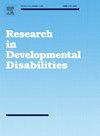有学习障碍的青少年学生使用辅助技术的障碍和促进因素:日常使用和不太频繁使用的混合方法比较
IF 2.6
2区 医学
Q1 EDUCATION, SPECIAL
引用次数: 0
摘要
本混合方法研究通过比较每天使用辅助技术的学生(N= 48)和不经常使用辅助技术的学生(N= 31)的观点,探讨了7-10年级学习障碍学生(N=79)使用辅助技术的影响因素。学生的感知是通过一项在线调查获得的,该调查测量了可能影响AT使用的个人特征(AT和LD耻辱、学术自我概念、AT的感知影响)和环境促进因素或障碍(AT教师支持)。卡方检验显示AT使用频率与AT教师支持和AT感知影响之间存在显著关联。专题分析表明,虽然两组人都认为AT很有价值,但频繁使用的人比不经常使用的人有更高的学术自我概念和更少的障碍。这包括实施全面的AT教育者培训,建立校内AT支持团队,以及每年对学生进行AT检查,以确保AT有效地满足学生的需求,同时确定和纠正使用AT的障碍。本文章由计算机程序翻译,如有差异,请以英文原文为准。
Barriers and facilitators of assistive technology use among adolescent students with learning disabilities: A mixed methods comparison of daily and less frequent users
This mixed methods study examined factors influencing assistive technology (AT) use among students with Learning Disabilities (LDs) in grades 7–10 (N=79) by comparing the perspectives of students who used AT daily (n=48) and less frequent users (n=31). Student perceptions were obtained using an online survey measuring potential individual characteristics that would influence AT use (AT and LD stigma, academic self-concept, perceived impact of AT) and environmental facilitators or barriers (AT teacher support). Chi-square tests revealed significant associations between AT use frequency and AT teacher support and the perceived impact of AT. Thematic analysis suggested that while both groups view AT as valuable, more frequent users reported higher academic self-concept and fewer barriers than less frequent users. Implications include implementing comprehensive AT educator training, establishing in-school AT support teams, and conducting annual student AT check-ins to ensure that AT effectively meets the student’s needs while identifying and rectifying barriers to AT use.
求助全文
通过发布文献求助,成功后即可免费获取论文全文。
去求助
来源期刊

Research in Developmental Disabilities
Multiple-
CiteScore
5.50
自引率
6.50%
发文量
178
期刊介绍:
Research In Developmental Disabilities is aimed at publishing original research of an interdisciplinary nature that has a direct bearing on the remediation of problems associated with developmental disabilities. Manuscripts will be solicited throughout the world. Articles will be primarily empirical studies, although an occasional position paper or review will be accepted. The aim of the journal will be to publish articles on all aspects of research with the developmentally disabled, with any methodologically sound approach being acceptable.
 求助内容:
求助内容: 应助结果提醒方式:
应助结果提醒方式:


